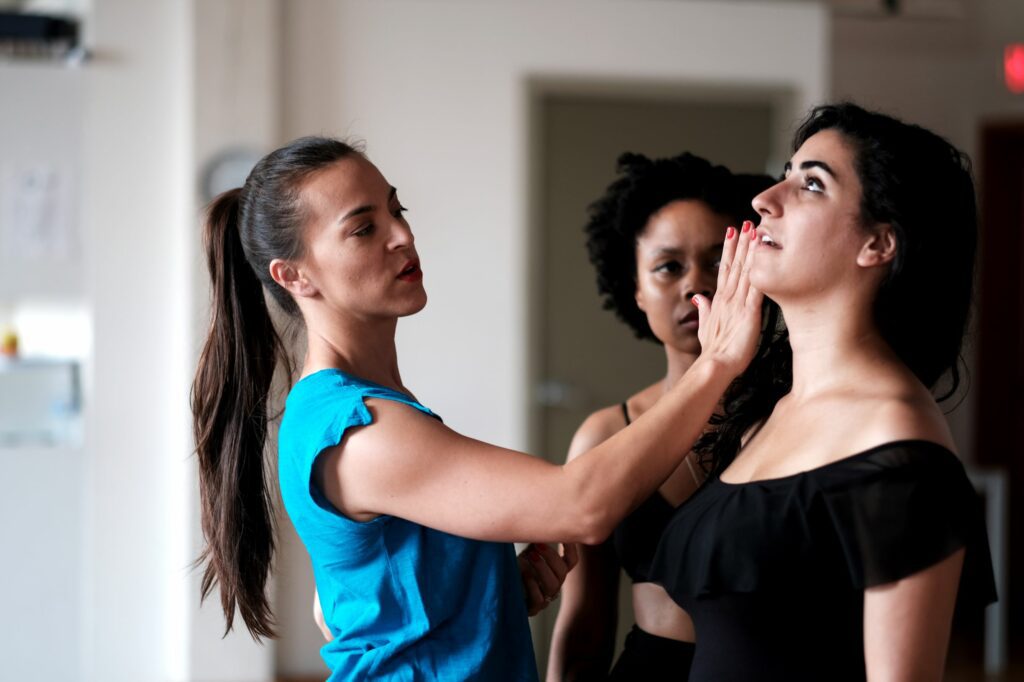What Is Intimacy Direction?
Theatre and opera lovers alike are familiar with the feeling of sitting in an audience and uneasily watching an act of sexual violence take place on stage. “Is the performer safe?” we ask ourselves and resume watching uncertainly.
For scenes of intimacy and violence alike, there is a growing group of individuals whose job it is to choreograph sex on stage. Their role is specific but crucial. No one worries that an actor is taking a real beating on stage because fight choreographers are ubiquitous for staging violent scenes. Their presence turns these scenes into more of a dance than a battle.

Thomas Hampson (Hadrian) and Isaiah Bell (Antinous) in Canadian Opera Company’s Hadrian. Photo: Michael Cooper
Meanwhile, some opera companies have been more reluctant than other performing arts sectors to also adopt intimacy directors. Siobhan Richardson, Ontarian and co-founder of Intimacy Directors International (IDI), says this may be because opera production teams are reluctant to relinquish control to yet another voice in the room. Still, Richardson maintains that her role is not to hijack rehearsals but to facilitate difficult conversations.
“We’ve been choreographing scenes of intimacy for a long time, we just haven’t necessarily called it ‘intimacy directing,’” says Richardson, who is also a fight choreographer. “The industry as a whole recognized the need for it during #MeToo.” Richardson and her compatriots at IDI are working on codifying a method for how to approach sex scenes. In 2018, Canadian Opera Company hired her for their premiere of Hadrian, the new opera by Rufus Wainwright and Daniel MacIvor centred on a love story between two men with ample intimate scenes.
“We didn’t have sound designers 50 years ago. With all the new technology, we have new jobs all the time—now we have projectionists. When we had projectionists in a show I did 10 years ago it was like, ‘Woah, what is this new thing!?,’” Richardson says. Hopefully, intimacy direction will go the way of projection specialists—mainstream.
Giving performers the respect they deserve
Richardson became interested in intimacy coaching while working as an actor, experiencing moments of uncertainty and awkwardness during a kissing scene. She was lucky to work through it in a supportive environment but she realized the need for others in her position, those in a less comfortable work space.
The worst-case scenario, Richardson says, is someone bulldozing their scene partner’s boundaries due to lack of communication or unprofessional intentions: “You get a case of someone sexually harassing or assaulting somebody in front of an audience and that’s not performance. That’s assault.” These things happen when critical conversations are not front-loaded before rehearsals even start.
“It is valuable to recognize that if a script says ‘they kiss’ and you don’t want to kiss somebody, then you should talk to your director about that ahead of time,” Richardson says. “An intimacy director can make it look like you’re kissing without having to make contact but it is important to make time in rehearsal to set that choreography.”
Richardson teaches that boundaries should not be understood as “no’s” but rather as the the “edge of our yes space, they help us outline what is available.” She reminds performers (and audiences) that a scene does not have to hurt to be a better performance, and that a story can still work while working within everyone’s boundaries.
For those concerned that choreographing sex may remove a raw, intimate element, it’s important to remember that what’s happening on stage is not sex—it’s professional acting. Performers go up there to tell the same story, night after night.

Rehearsal still from Serenity Wild at Summerworks Performance Festival, August 2017. Intimacy Director Siobhan Richardson, Dainty Smith and Julia Matias, co-produced by Tender Container and the frank theatre company. Photo by Blaize Thomas.
Doing justice to our beloved stories
While a big part of Richardson’s job is to help actors feel safe, another crucial component is doing justice to the story. When a script says “they make love,” it leaves ample room for interpretation. “If we haven’t set specific [choreography], nothing’s being repeated…[the sex scene] gets improvised every night,” Richardson says.
Maybe one performer hung out in their pajamas all day before coming to work. Maybe one witnessed an accident on the way to rehearsal: “Your performers may be very in tune and they actually end up improvising an excellent story every night,” Richardson says, “But what we often find is that the storytelling is dependent on how those performers are [feeling] that day.”
Respecting actors boundaries and doing a better job of telling a story? Is intimacy direction a panacea? In fact, it may actually have a musical utility for staging operas, as well: “[The singers] know, ‘we’re going to touch in this way and now I have the breath and space to hit these notes five seconds later.’ It’s also about serving the voice and the music,” Richardson says.
So, intimacy direction doesn’t mean that opera needs to burn those beloved librettos that feature an unsavoury sampling of misogyny and sexual violence on a pyre. It means that those problematic pieces can be staged in a safer way—it’s important to remember that violent sexual scenes are difficult on everyone, including the person playing the abuser.
“Let’s not throw the baby with the bathwater. There is some gorgeous, fabulous art that we keep alive,” Richardson says, “[But] the subject matter is often misogynistic. The established structures feel like they can’t budge and let in one more voice but…I’m not coming to tell you that you’ve done it wrong or that you’re a monster. I’m coming in to say ‘here’s a process’…[so] everyone involved is confident in what they’re doing.”









